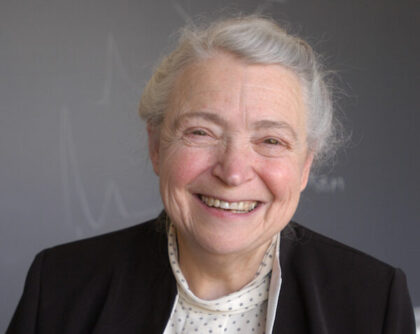Mildred S. Dresselhaus
Former Professor of Physics, Emerita
Former Professor of Electrical Engineering, Emerita
November 11, 1930 - February 20, 2017
In Memoriam:
November 11, 1930 – February 20, 2017
Research Interests
Recent research activities in the Dresselhaus group that have attracted wide attention are in the areas of carbon nanotubes, bismuth nanowires and low dimensional thermoelectricty.
Regarding carbon nanotubes, which were previously predicted to be either semiconducting or metallic depending on their geometries, we have been developing the method of Raman spectroscopy as a sensitive tool for the characterization of single wall carbon nanotubes, one atomic layer in wall thickness. This work started in earnest with the initial observation (with Rao et al. at the University of Kentucky in 1997) of the Raman spectra from bundles of single wall carbon nanotubes and showing a strong enhancement of the spectra through a diameter selective resonance Raman effect. Next we showed characteristic differences between the Raman profile of the G-band depending on whether the nanotubes were metallic or semiconducting. This work eventually led to the observation of Raman spectra from one single nanotube, with intensities under good resonance conditions comparable to that from the silicon substrate, even though the ratio of carbon to silicon atoms in the light beam was approximately only one carbon atom to one hundred million silicon atoms. All Raman features normally observed in single wall nanotube (SWNT) bundles are also observed in spectra at the single nanotube level, including the radial breathing mode, the G-band, the D-band and the G’-band. However, at the single nanotube level, the characteristics of each feature can be studied in detail, including its dependence on diameter, chirality, laser excitation energy and closeness to resonance with electronic transitions. Of particular importance is the uniqueness of the electronic transition energies for each nanotube, which are described in terms of two integers (n, m) which uniquely specify the geometrical structure of the nanotube, including its diameter and chirality. The high sensitivity of the Raman spectra to diameter and chirality, particularly for the characteristics of the radial breathing mode, which are also uniquely related to the same (n, m) indices, thereby providing a structural determination of (n, m) at the single nanotube level. The (n, m) assignments made to individual carbon nanotubes are corroborated by measuring the characteristics of other features in the Raman spectra that are sensitive to nanotube diameter and chirality. Raman spectroscopy potentially provides a convenient way to characterize nanotubes for their (n, m) indices, in a manner that is compatible with the measurement of other nanotube properties, such as transport, mechanical and electronic properties at the single nanotube level, and the dependence of these properties on nanotube diameter and chirality.
We have devised a way to prepare arrays of aligned bismuth nanowires down to 7 nm diameter (embedded in an anodic alumina template), 50-100 microns in length, with a wire density of ~ 1011/cm2, with their wire axes along a common crystalline orientation, and preserving the crystal structure of bulk bismuth. We previously predicted a semimetal-semiconductor transition in bismuth nanowires as a function of nanowire diameter due to quantum confinement effects, and we have now succeeded in observing this effect through transport measurements. We are now studying the transport and optical properties of the nanowire arrays with particular relevance to enhancing their thermoelectric properties. For scientific studies we are developing techniques to make measurements of the resistance of single quantum wires as a function of nanowire diameter using a 4-probe method. The doping of bismuth with antimony, which is isoelectronic to bismuth, is of special interest for achieving an enhancement in thermoelectric performance, especially for p-type legs in thermoelectric devices. For this reason we are now studying the structure, electronic and transport properties of bismuth-antimony nanowires as a function of nanowire diameter and antimony concentration.
Biographical Sketch
Courtesy of TeachingExcellence MIT | YouTube
Professor Mildred Dresselhaus, “The Queen of Carbon”, is a native of the Bronx, New York City, where she attended the New York City public schools through junior high school, completing her high school education at Hunter College High School in New York City. She began her higher education at Hunter College in New York City and received a Fulbright Fellowship to attend the Cavendish Laboratory, Cambridge University (1951-52). Professor Dresselhaus received her master’s degree at Radcliffe College (1953) and her Ph.D. at the University of Chicago (1958).
Professor Dresselhaus began her MIT career at the Lincoln Laboratory. During that time she switched from research on superconductivity to magneto-optics, and carried out a series of experiments which led to a fundamental understanding of the electronic structure of semi-metals, especially graphite.
A leader in promoting opportunities for women in science and engineering, Professor Dresselhaus received a Carnegie Foundation grant in 1973 to encourage women’s study of traditionally male dominated fields, such as physics. In 1973, she was appointed to The Abby Rockefeller Mauze chair, an Institute-wide chair, endowed in support of the scholarship of women in science and engineering.
Professor Dresselhaus has greatly enjoyed her career in science. On her experience working with MIT students, she says, “I like to be challenged. I welcome the hard questions and having to come up with good explanations on the spot. That’s an experience I really enjoy.” Thus far, she has graduated over 60 Ph.D. students.
This biographical text was adapted from Harvard Magazine’s January-February 1980 feature article on Professor Mildred S. Dresselhaus.
Obituaries:
- Institute Professor Emerita Mildred Dresselhaus, a pioneer in the electronic properties of materials, dies at 86
- Letter to the MIT community regarding the death of Mildred Dresselhaus [MIT News Office, 2.21.2017]
- Mildred Dresselhaus, IEEE Medal of Honor Recipient Known as the “Queen of Carbon,” Dies at 86 [IEEE Spectrum, 2.22.2017]
- Dr. Mildred Dresselhaus, 86, much-honored MIT physicist, mentor to female scientists [Boston Globe, 2.23.2017]
- Mildred Dresselhaus, the Queen of Carbon, Dies at 86 [New York Times, 2.23.2017]
- Mildred Dresselhaus, ‘Queen Of Carbon’ And Nanoscience Trailblazer, Dies At 86 [NPR, 2.24.2017]
- Mildred Dresselhaus – Superlattice Structures for Thermoelectric Devices [National Inventors Hall of Fame]
- Mildred S. Dresselhaus (1930-2017) [Nature, 3.16.2017]
- Mildred Dresselhaus, the ‘Queen of Carbon Science,’ Has IEEE Medal Named in Her Honor [IEEE Spectrum, 2.6.2020]
- Celebrating the Life and Career of Millie Dresselhaus: The Queen of Carbon Science [ACS Publications]
- Support the Millie Dresselhaus Fund for Science & Society
Courtesy of MIT Infinite History Project | YouTube

Improbability Walk at MIT.nano honors Mildred Dresselhaus
Courtyard space celebrates beloved professor’s research and mentorship.
Awards & Honors
- 2017 // Benjamin Franklin Medal (awarded posthumously) "For her fundamental contributions to the understanding and exploitation of carbon nanomaterials, such as the spheres known as buckminsterfullerenes, the cylindrical pipes called nanotubes, and the single-atom-thick sheets of carbon known as graphene, and for launching the field of low-dimensional thermoelectricity, the direct conversion of heat to electricity."
- 2015 // IEEE Medal of Honor "in recognition of her 'leadership and contributions across many fields of science and engineering'."
- 2014 // Presidential Medal of Freedom "recognizing "individuals who have made especially meritorious contributions to the security or national interests of the United States, to world peace, or to cultural or other significant public or private endeavors."
- 2013 // Arthur R. von Hippel Award, Materials Research Society
- 2012 // Kavli Prize in Nanoscience "“for her pioneering contributions to the study of phonons, electron-phonon interactions, and thermal transport in nanostructures.”
- 2010 // Enrico Fermi Award, US Department of Energy (co-recipient with Burton Richter)
- 2009 // American Chemical Society (ACS) Award for Encouraging Women into Careers in the Chemical Sciences
- 2009 // Vannevar Bush Award ""For her extraordinary contributions to the field of condensed matter and materials physics, especially in nanoscience and carbon science relevant to energy-related applications; for her extensive public service to the scientific community through national leadership and promotion of international collaboration in science; and for her historic role in enlarging opportunities for women in science in the United States and the world."
- 2008 // Oliver E. Buckley Condensed Matter Prize (APS) ""For pioneering contributions to the understanding of electronic properties of materials, especially novel forms of carbon."
- 2007 // L'Oréal-UNESCO Award for Women in Science
- 2007 // Oersted Medal (AAPT) "for her outstanding, widespread, and lasting impact on the teaching of physics."
- 2004 // IEEE Founders Medal "for outstanding contributions in the leadership, planning, and administration of affairs of great value to the electrical and electronics engineering profession."
- 2001 // Karl Taylor Compton Medal for Leadership in Physics (AIP)
- 2000-2001 // Director, DOE’s Office of Science
- 2000 // Weizmann Institute's Millenial Lifetime Achievement Award
- 1999 // Dwight Nicholson Medal for Outreach (APS) "For being a compassionate mentor and lifelong friend to young scientists; for setting high standards as researchers, teachers and citizens; and for promoting international ties in science."
- 1990 // National Medal of Science “for her studies of the electronic properties of metals and semi-metals, and for her service to the nation in establishing a prominent place for women in physics and engineering.”
- 1985 // National Academy of Sciences Member
- 1984 // President, American Physical Society
- 1972 // American Physical Society Fellow
Key Publications
-
M. S. Dresselhaus and P. C. Eklund, Phonons in Carbon Nanotubes, Advances in Physics 49, 705-814 (2000).
-
A. Jorio, G. Dresselhaus, M. S. Dresselhaus, M. Souza, M. S. S. Dantas, M. A. Pimenta, A. M. Rao, R. Saito, C. Liu, and H. M. Cheng, Polarized Raman Study of Single Wall Semiconducting Carbon Nanotubes, Phys. Rev. Lett. 85, 2617-2620 (2000).
-
A. Jorio, R. Saito, J. H. Hafner, C. M. Lieber, M. Hunter, T. McClure, G. Dresselhaus, and M. S. Dresselhaus, Structural (n,m) determination of isolated single wall carbon nanotubes by resonant Raman scattering, Phys. Rev. Lett. 86, 1118-1121 (2001).
-
A. Jorio, A. G. Souza Filho, G. Dresselhaus, M. S. Dresselhaus, R. Saito, J. H. Hafner, C. M. Lieber, F. M. Matinaga, M. S. S. Dantas, and M. A. Pimenta, Joint density of electronic states for one isolated single wall carbon nanotube studied by resonant Raman scattering, Phys. Rev. B 63, 245416 (2001).
-
A. G. Souza Filho, A. Jorio, J. H. Hafner, C. M. Lieber, R. Saito, M. A. Pimenta, G. Dresselhaus, and M. S. Dresselhaus, Electronic transition energy Eii for an isolated (n,m) single-wall carbon nanotube obtained by anti-Stokes/Stokes resonant Raman intensity ratio, Phys. Rev. B 63, 241404R (2001).
